The oldest cotton fabric was found in Mexican cave dating nearly 7000 years ago. Today, there are about 40 types of cotton and is most popular fabric in the world. Natural cotton fabric is durable but biodegradable, strong and resists abrasion. The fiber of cotton is almost pure cellulose and it comes from cotton fruit, known as bolls. According to the Organic Trade Association, organic cotton is grown without the use of toxic pesticides or fertilizers. Almost all conventional cotton is genetically modified. In fact, in order to be classified as organic, cotton must be grown in soil that has been free of prohibited chemical substances for at least three years prior to harvesting. In this article we will delve into health benefits of organic cotton fabric.
As most natural fibers organic cotton fabric has health benefits that cannot be ignored. Organic cotton fabric provides a moderate UV protection and has antibacterial properties making it ideal for clothing and even medical use. This natural fiber helps to cool in hot weather conditions and is known as one of the best natural fabrics for summer wear.
Being naturally soft and hypoallergenic organic cotton fabric is kind to sensitive skin, does not cause irritation and diaper rashes. Cotton is known to improve sleep and provide relaxation. Variety materials made of organic cotton fibers are valued in babywear and underwear due to its softness and ability to stretch, being very pleasant to wear close to skin.
Only organically grown and produced cotton is free of chemicals and is eco-friendly.
Growing, harvesting, producing and buying organic cotton can greatly benefit our fragile environment, small organic farms, you and your family health. Avoiding constant exposure to pesticides, herbicides and other chemicals through clothes we wear 7 days a week can reduce a risk of various health conditions and make us live more joyful and conscious life.
Organic Only: Environmentally Friendly & Free of Chemicals
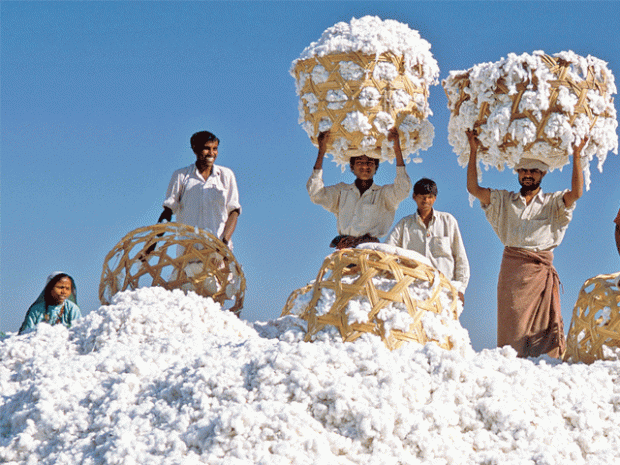
As earlier mentioned conventional cotton is farmed using pesticides and synthetic fertilizers, later during the process from fiber to fabric it is treated with toxic chemical substances. For this reason, conventional cotton garments release pesticide toxins into water when washed and into air when worn or used in everyday life. Enormous amount health-related issues are related to the toxins we are bombarded by every day. Imagine, if your beloved piece of cloth made of conventional cotton constantly releases toxins into the air you breath and has regular interaction with your skin. Women should be highly concerned when choosing feminine hygiene products as tampons and sanitary pads are made of conventional cotton.
Nowadays, a variety of nanotechnologies are applied to cotton fiber or fabric in expectancy to enhance its natural properties, to transform it into high-tech fabric or engineering material, to change its physical characteristics, to infuse color or make it even more versatile. To be more precise, nanotechnology is a manipulation of matter on an atomic, molecular, and supramolecular scale. According to European Public Health Association nanoparticles “may accumulate in biological systems and persist for a long time, which makes such nanoparticles of particular concern. There remain many unknown details about the interaction of nanoparticles and biological systems and more information on the response of living organisms to the presence of nanoparticles.” Cotton is preferred material for firefighter uniforms as it can be coated with fire-resistant substances.
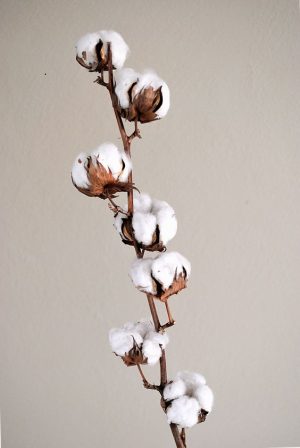
Also, 90% of conventional cotton plants are genetically modified (GM) to become pest resistant, provide fast crops and fast profit. In the long run agricultural individuals working in genetically modified or conventional crop fields suffer from chronic and acute health issues, such as allergies, immune disorders, liver and kidney damage, endocrine dysfunction, cancer. Even a rise in suicides among cotton farmers/workers in particular is being noted in India.
Good news is that organic cotton is still available. Instead of synthetic fertilizers organic cotton growers use organic manure to fertilize organic cotton crop No toxic pesticides or herbicides are used. As organic cotton does not contain pesticides and is not treated with toxic chemicals later, both farmers and wearers can enjoy chemical free environment and products without deteriorating their health and planet. Organic cotton being chemical free is perfect for people with skin allergies or irritations. When shopping for cotton garments or fabric look for a “certified Organic Cotton or Wool and Fair Trade” label attached to avoid conventional cotton. Educating oneself, buying organic and environment friendly goods creates a demand for chemical free products, supports organic farmers and companies, helps fragile eco-system of Mother Earth and saves human wellbeing.
Cools & Ventilates
Cotton fabric has great cooling properties and is one of the best fabrics for hot weather. Cotton fibers keep the fabric away from skin creating a thin layer of air. This air gap not only helps to stay cool in summer but also maintains warmth in colder conditions. In summer, body cools when air between skin and cotton clothing hits moist skin. Actually because of fiber specifics and weaving cotton is perfect fabric when your body temperature needs to be lowered rapidly. Also, the same air gap makes cotton fabric a thermal insulator at the same time.

Naturally cotton fibers do not trap heat, allow air to circulate and move freely through fabric. Cotton bed sheets is a good alternative for those who sleep in hot conditions, experience night sweats or have hot flashes. Cotton allows moisture to evaporate and prevents it from building up between skin and clothing.
Nevertheless cotton fabric tends to soak moisture making it a good choice for exercise clothes, underwear and sleepwear. Organic cotton fiber absorbs body sweat like a towel discouraging the growth of bacteria and yeast. Studies have found that cotton fabric can absorb water up to one-fifth of its weight before it feels damp.
Furthermore, cotton material do not stick onto skin, does not irritate it and works like an air conditioner for the body providing comforting cooling. However, the downside is that cotton fabric tends to become heavy when wet and may also show moisture stains in armpits or by collar when light colored fabric is worn.
Some people say that organic cotton clothes smell better than conventional cotton garments. For sure, a 100% natural cotton outfit will stay crisp and fresh throughout the entire day.
Hypoallergenic & Antibacterial Properties
As per organic standards, organic cotton is grown and manufactured without toxic chemicals so organic cotton wearers are no longer exposed to chemicals. Natural cotton fibers is hypoallergenic, do not cause skin allergies or irritation.
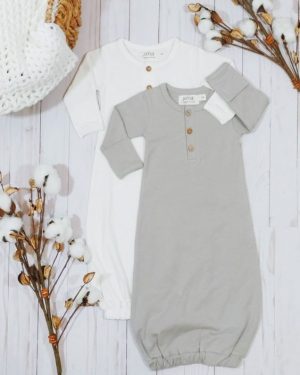 Organic cotton is much softer to skin than conventional counterpart and is recommended to people with sensitive and allergic skin. Organic cotton is an ultimate fabric for baby clothing because of its gentleness to delicate infant skin.
Organic cotton is much softer to skin than conventional counterpart and is recommended to people with sensitive and allergic skin. Organic cotton is an ultimate fabric for baby clothing because of its gentleness to delicate infant skin.
It is important to mention that using cotton fabric may reduce respiratory problems because it is resistant to pollen, dirt and dust mites.
Cotton fiber fabric has the natural ability to prevent bacterial growth. Wearing cotton underwear reduces risk of infection. Bacterial infection is a common issue that women face. Alongwith wearing cotton panties, V-Luxe probiotics will help with BV. Due to its softness, hypoallergenic and antibacterial properties cotton fabric and cotton wool is used in healthcare for many years. Also, cotton is used for medical purposes because it is flexible and provides a ready substrate for locking in health-promoting compounds. Absorbent cotton is known as surgical cotton, used to absorb fluids. Natural cotton is ideal for wound dressings. Cotton can be sterilized by steam.
Provides Moderate UV Protection
Sun protection level of fabric is determined by its weave, color and weight. Natural cotton fibers are not chemically stripped of its natural wax and most weaves have typical smoothness and weight that reflects or absorbs light.
According to Skin Cancer Foundation a white cotton t-shit has an SPF of about 7, but once cotton gets wet an SPF drops down to about 3. Also, it was found that white cotton shirts filters slightly more UV than printed colored shits.

A study conducted by BMC Dermatology Journal (2004) demonstrated that “dyeing cotton fabrics with natural colorants increases the ultraviolet protective abilities of the fabrics and can be considered as an effective protection against ultraviolet rays.” Also in same study it was concluded that cotton UPF values can be increased by the depth of color shade. The darker the color the higher ultraviolet protection factor rating is.
In 2016, Textile Research Division of National Research Centre (Egypt) carried out a study on natural colorants (red onion peel, madder, chamomile and red onion/chamomile mixture) as UV protectors on fabrics. It was concluded that the fabrics dyed with natural colorants (red onion peel, madder, chamomile and red onion/chamomile mixture) strongly blocked UV radiation.
Also, it was noted that when white T-shirts were dyed blue, such cotton shirts filtered more UV than for example yellow color cotton shirts.
For your interest, it was discovered that weight of different knitted fabric structures can contribute to levels of UPF (ultraviolet protection factor).
Comfort & Holistic Properties
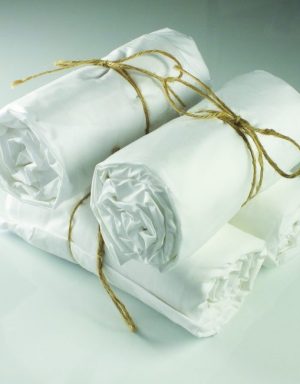
Most products made of organic cotton are especially soft and smooth because they are not treated with cruel chemicals, colorants and bleaching substances. Organic cotton fabric is comfortable and pleasant to wear as it stretches easily. That is why cotton is a very popular fabric in underwear fashion.
Due to its natural softness organic cotton fabric is well known for its ability to provide physical ease and relaxation. Indeed, holistic practitioners prefer organic cotton to conventional one when working on recovery from illness or providing palliative treatment. Cotton sheets are proven to help improve sleep quality. Natural cotton fabric is known not to emit static electricity.
In spiritual level garments made of natural fibers provide a better protection from negative energies. It is believed that natural cotton fabric can attract Divine Consciousness (Chaitanya) because of its spiritual purity. Cotton symbolizes protection, simplicity, harvest, rain.
Organic Cotton Fabric Perfect for Babies
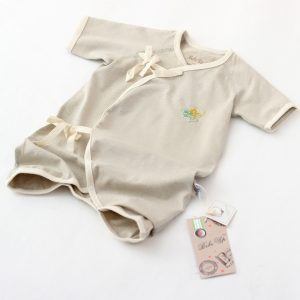
Organic cotton is the most suitable fabric for kids clothing, especially babywear as it is grown and produced without harmful chemicals, its texture is very pleasant against delicate baby skin and no other plant fiber can offer same level of softness.
Cotton fabric is breathable, durable and can absorb a lot of moisture before becoming damp. Cotton diapers are ideal to keep baby dry, cool, comfortable and healthy. Organic cotton diaper or underwear allow free airflow, do no rub against baby’s subtle skin reducing its sensitivity and protecting against diaper rash. Visit Q for Quinn Inc. for high-quality cotton underwear. 100% organic cotton fabric tends not to irritate skin and does not cause allergies – another win-win for babe’s undisturbed sleep and wellbeing.
Benefits Women’s Health

It is long known that wearing cotton panties helps to fight vaginal infections and reduces sensitive skin irritation. Cotton fiber is breathable naturally, keeps excessive moisture away from skin and prevents of yeast and odor causing bacteria production. In fact, cotton is one of very few materials that become stronger when wet and it can be sterilized after use. Wearing organic cotton underwear does not cause allergic reactions as synthetic textiles.
Thin and sensitive vagina skin it absorbs toxins and chemicals more easily than the outer body skin, for this reason organic cotton fiber tampons should be prioritized.
Organic cotton tampons are free from pesticides, toxins, dyes and bleaches. Traditional tampons usually contain a mix of conventional cotton and synthetic ryon. Sometimes recurring vaginal itching is caused by allergic reactions to the fragrances and chemicals found in traditional tampons.
According to Andrew Chevallier, author of Encyclopedia of Herbal Medicine, “cotton seed oil is used to treat heavy menstrual bleeding and endometriosis.” Cotton root bark was known to induce labor, stimulate uterine contractions, reduce menstrual flow, encourage breast milk secretion and blood clothing but is rarely used in modern medicine for such benefits today.
Cottonseed Oil for Skin & Hair
It should be reminded that cotton is actually a plant. Only fluffy fiber that sits around the seed as a protective layer is used for textile production. Its seeds, roots, leaves and stems are used make cotton extract and cottonseed oil. Cottonseed oil and cotton extracts contain vitamin E, omega-3 fatty acids and antioxidants and are popular not only in medicine products but also in beauty industry. Cotton helps to fight free radicals, shows the ability to reduce inflammation and can soothe and moisturize skin. It acts as a barrier between skin and foreign pathogens.
Cottonseed oil is used to restore heat and chemically damaged hair. Cottonseed oil contains fatty acid linoleic acid that helps promote hair growth and prevents hair loss.
Continue reading:
PART I: Health Benefits of Organic Linen Fabric
PART III: Health Benefits of Organic Silk Fabric
PART IV: Health Benefits of Organic Wool Fabric
PART V: Health Benefits of Organic Hemp Fabric
Published in August/September 2018: BUY NOW
Author: Sheeba Magazine|Article published: August/September 2018 |Cannot be copied or republished without written permission by Sheeba Magazine.

